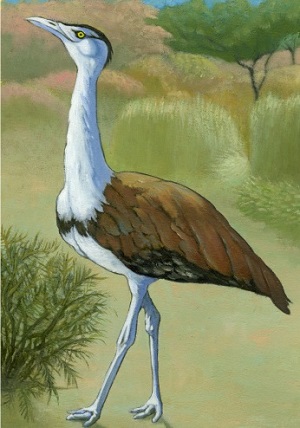Oct 14, 2025
Oct 14, 2025
 The Great Indian Bustard (Ardeotis nigriceps) or Indian Bustard is a magnificent large bird with crane like appearance due to its long legs and horizontal body. This heavy bodied flying bird is a native of India and surrounding regions in Pakistan.
The Great Indian Bustard (Ardeotis nigriceps) or Indian Bustard is a magnificent large bird with crane like appearance due to its long legs and horizontal body. This heavy bodied flying bird is a native of India and surrounding regions in Pakistan.
13-Apr-2014
More by : Dr. Jaipal Singh

|
Dear Padmajaji, Though there is a long list of endangered species, somehow this fascinating bird always remained in my psyche despite the event being more than three decades old. Hence I chose to write on this bird. I shall endeavor to find the work of the Alva Brothers - Niret and Nikhil on the subject. Thank you so much for liking the article. |

|
Thank you so much, Kulbirji, for liking the article and finding it useful for spreading awareness. |

|
Dear Mr Ashby, I am indeed impressed and grateful for your valuable comments. I would, however, like to make a few points as under: Notwithstanding the fact that the concept of the ‘Natural Selection’ was developed by Charles Darwin in the absence of any valid theory of heredity in his time, it continues to be the cornerstone of the modern Biology. The Creationist theory is centred round the belief that the living organisms had originated through the act of divine creation. Incidentally, ‘Biblical Creationism’ is not the only theory; human race has such other theories as well of creation by the Supreme Being, including one in Hindu Theology. Perhaps the concept of ‘Human Selection’ referred to in your analysis would at best be defined as the ‘Artificial Selection’, a process whereby human breeders favour reproduction of animals and plants with genetically desirable traits. Mahatma Gandhi once said – “The earth has enough for human needs, but not for human greed.” The large scale exploitation of nature and continuous destruction, degradation and depletion of natural resources for larger human comfort have led to the dangerous environment and ecological imbalances over the years making it unsuitable for many species already extinct or on the verge of extinction. Such human acts perhaps do not fit well in the natural selection process through the survival of the fittest. It is in this context that the same human race is expected to take corrective and remedial measures to save planetary life. |

|
A very informative and well written article on the Great Indian Bustard. If I remember right, about a decade back, the Alva Brothers - Niret and Nikhil - had made a documentary on this. The article amply demonstrates your ind depth knowledge and concerns for conservation of the endangered species and wild life. Hope those in power and can do something, listen to your sensible suggestions and solutions. Thanks for sharing this article, Jaipalji. |

|
Jaipal Sahib, Thank you so much for your informative article on the great Indian bustard, and spreading the message of urgent conservation measures needed. |

|
Today’s conservation of endangered species in the wild all over the world, including the tiger and the great white shark, is actually anti-evolutionary in its thinking, since it finalises these species, where evolution would keep evolving them - or as a great many species have suffered in the past - render them extinct. Survival by 'human selection' has taken over that by 'natural selection'. This empowerment is providential, for man's mastery over animals was granted in the garden of Eden (Gen 1: 26 -29). Perhaps then, survival by 'human selection' vindicates creationist theory over evolutionary theory, hereby debunked. |